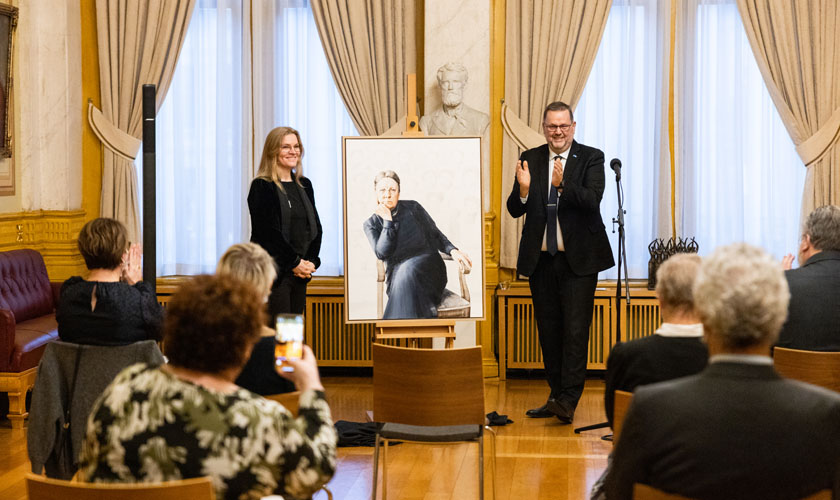
The artist Marianne Wiig Storaas with Svein Harberg, First Vice President of the Storting. Photo: Peter Mydske/Storting.
New portrait of the Storting’s first regular female MP
A century after Karen Platou (Conservative Party) first took her seat in Parliament as a regular Member of Parliament (MP), a new portrait of the pioneer has been unveiled in the Storting.
The artist Marianne Wiig Storaas has painted the portrait of Platou.
“It’s a great honour to portray this strong and historically significant woman, the first female MP to have a regular seat in the Storting,” said Ms Storaas.
Svein Harberg, the Storting’s First Vice President, unveiled the portrait in the Eidsvoll Gallery on Tuesday 11th January. This was 100 years to the day after Karen Platou first took her seat in the Storting as a regular MP.
“Until now, the Storting has had only five portraits of women among all the men on display, so it’s high time we gave Karen Platou the prominent place she deserves in the collection itself and in the narrative of the Storting as a whole,” Mr Harberg said.
Karen Platou was a Substitute MP from 1920 to 1921, and was elected as a regular MP at the 1921 parliamentary election. When Parliament opened on 11th January 1922, Platou became the first woman to take her seat in the Storting as a regular MP.
When, three months into the session, she was asked what it was like to take her seat in the Storting, Platou replied, “I consider my work here to be that of a pioneer.” She said that it was difficult to get support for parliamentary business, but added that she was pleased fellow MPs often asked for her advice on matters that concerned “women and the home”. In Platou’s view, the very fact that she was consulted on such issues was an important step in the right direction. She was also pleased that the form of address during parliamentary debates had been changed from “Gentlemen” (“mine herrer”) to “Honourable Members” (“ærede representanter”) in recognition of the presence and participation of women in the Chamber.
Platou was especially active in issues relating to social affairs, welfare in the home, working conditions for homemakers, women’s rights, and housing. As a Substitute MP, she was a member of the Salary Committee. She then served on the Justice Committee after becoming a regular MP.
Karen Platou served as a regular MP during the 1922-1924 parliamentary term before she once again became a Substitute in the following term. In 1927, she gave notice to the Oslo Conservative Party that she no longer wished to be considered for election.
“The portrait of Karen Platou presents us with a powerful depiction of the pioneer she was. It will be hung in a prominent place in the Storting and remind us how vital it is for democracy that the entire population is represented,” Svein Harberg said.
The portrait of Karen Platou is one of the ways by which the Storting is marking one hundred years of women in Parliament.
“At last Platou has become part of the collection. Portraits of women in her time were often depicted as simply women, and not because they distinguished themselves from the masses through their social or intellectual significance. They were painted by men, so a lot has changed since then. Platou was an active agent for these changes,” Marianne Wiig Storaas added.
Ms Storaas, who is from Oslo, was chosen to paint the portrait after the Storting’s Presidium announced a competition for the assignment in the autumn of 2020. KORO, the government agency responsible for public art in Norway, has assisted the Storting in the process.
Last updated: 12.01.2022 14:50